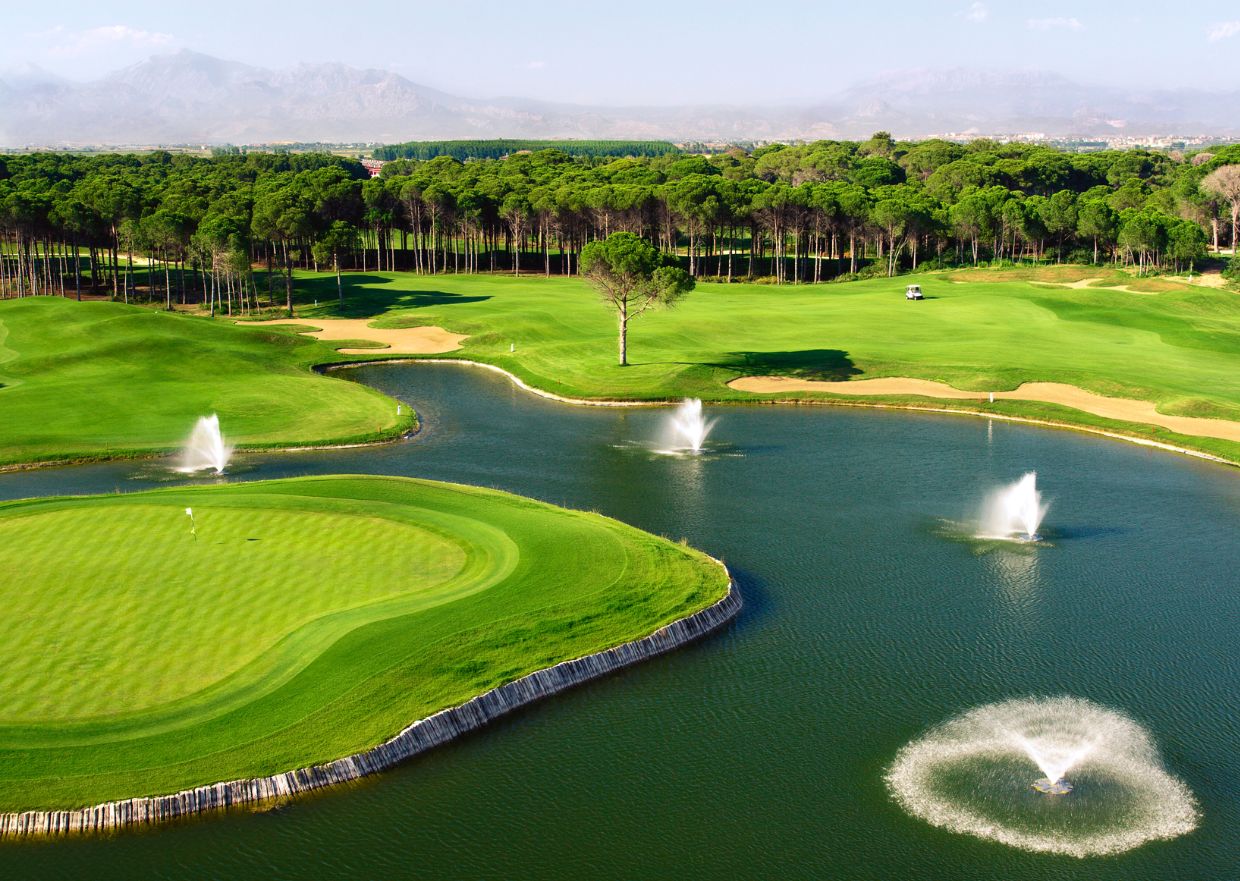Golf Sustainability: Key Measures to Lower Environmental Impact
In an era where sustainability has become a cornerstone for industries worldwide, golf sustainability emerges as a vital focus for eco-friendly golf courses and enthusiasts alike. Addressing the golf course environmental impact is not just about enhancing the greenery that defines the sport but involves a comprehensive approach to reducing carbon footprint, optimising water resources, and minimising energy consumption. With the growing awareness of golf’s carbon emissions and water usage, the pursuit of sustainability within this leisure activity underscores a commitment to preserving natural resources and promoting a healthier planet. This article delves into the essential measures and practices that aim to lower the environmental impact of golf courses, offering a path towards a more sustainable golf development.
The journey towards golf sustainability encompasses a range of eco-friendly golf practices, from implementing water-saving irrigation techniques to adopting energy-efficient golf course operations. This discussion will explore the current environmental challenges faced by golf courses, including the critical need for reducing carbon footprint and conserving water resources. Readers will gain insight into sustainable practices that not only benefit the environment but also offer economic advantages through efficient management. The article will underscore the importance of sustainability in golf, highlighting innovative solutions and the positive outcomes associated with embracing green golf initiatives. Through this exploration, stakeholders in the golf industry are invited to consider how their efforts in sustainability can contribute to a lasting legacy for the sport and the environment.
The Current Environmental Challenges in Golf
High Water Usage
Golf courses are notorious for their extensive water consumption. In the United States alone, over two billion gallons of water are used daily to irrigate these landscapes [1]. This massive water use not only stresses local water resources but also raises concerns about sustainability and environmental responsibility. Implementing water-efficient irrigation systems and exploring rainwater harvesting techniques can help address this challenge and promote reduced water consumption on eco-responsible golf courses.
Chemical Dependence
The reliance on chemicals to maintain the pristine condition of golf courses has significant environmental repercussions. Heavy use of pesticides and fertilisers can lead to groundwater pollution and negatively affect the surrounding ecosystems. Studies have highlighted the high levels of toxicity that can impact local residents and the environment due to these practices [1]. Adopting integrated pest management strategies and reduced chemical use can mitigate these negative effects and contribute to eco-friendly course maintenance.
Wildlife Habitat Disruption
Although golf courses can serve as important wildlife corridors, the management practices often disrupt local ecosystems. Over 100 courses in England, however, are designated as Sites of Special Scientific Interest, playing a crucial role in conserving habitats for various species [2]. Efforts are being made to manage these areas in environmentally beneficial ways, such as maintaining roughs that support diverse plant and animal life, which adds to the golfing experience and helps in natural features preservation [2].
Eco-Friendly Practices for Golf Courses
Utilising Renewable Energy
Many renewable energy golf courses are now harnessing renewable energy sources, such as solar panels and wind turbines, to power various aspects of their operations. This shift not only reduces their dependency on non-renewable energy but also significantly lowers their carbon footprint. By integrating these clean energy systems, golf courses can operate more sustainably by powering lighting, irrigation pumps, and clubhouse facilities with renewable sources [3]. Embracing resource efficiency through renewable energy adoption is a key aspect of sustainable golf management.
Organic Alternatives for Course Maintenance
In the realm of green golf course maintenance, there is a growing trend towards using organic alternatives. Organic fertilisers and fungicides are increasingly seen as viable options for maintaining turfgrass. These organic products help enhance soil health, which in turn supports healthier turf that is more resilient to disease and pests. Moreover, practices like compost tea applications and the use of beneficial microbes are revolutionising golf course management by providing effective, eco-friendly golf course solutions for turf care [4].
The adoption of native vegetation landscaping is another significant step towards ecological sustainability on golf courses. Native plants require less water, fertiliser, and pesticides, which not only cuts down maintenance costs but also supports local biodiversity. This approach not only contributes to environmental conservation but also offers golfers a unique and more natural golfing experience [3]. Incorporating drought-resistant grasses and greywater irrigation systems further enhances the resource efficiency and sustainability of eco-conscious golf courses.
Economic Benefits of Sustainable Golf Course Management
Energy Cost Savings
Golf clubs can achieve significant financial savings through the adoption of sustainable golf practices. For instance, installing solar PV systems not only allows golf clubs to generate their own clean energy but also reduces their reliance on costly fossil fuels [5]. By incorporating solar panels, clubs like Saltford Golf Club have realised substantial long-term golf course energy savings, demonstrating the economic viability of sustainable golf guidelines [5]. Additionally, efficient energy management helps clubs manage their budgets more effectively, ensuring resources are allocated to enhance the golfing experience without financial strain [6].
Increased Market Appeal and Community Support
Sustainable golf course construction often sees an increase in market appeal due to their commitment to environmental and social impact responsibilities. Modern golf developments that prioritise sustainability tend to attract more members and visitors, enhancing their profitability and public reputation [7]. Moreover, engaging with local communities and promoting inclusivity and diversity in golf can strengthen community ties and support. By providing opportunities for community involvement and demonstrating a commitment to ethical practices, golf clubs can enhance their social value and appeal to a broader audience [8].
Conclusion
As this exploration of golf sustainability draws to a close, it’s clear that the sport’s future hinges on the adoption of eco-friendly practices and innovations that respect and protect our planet. The measures discussed—ranging from water conservation efforts and the use of organic maintenance alternatives to the integration of renewable energy sources—highlight a path forward that not only ensures the sport’s longevity but also enhances its appeal in an increasingly environmentally friendly golf market. These strategies, when implemented, serve not only to mitigate the environmental impact of golf courses but also to position them as leaders in the global push for sustainability. This comprehensive approach to eco-friendly golf practices underscores the significant role that the golfing community plays in advancing environmental stewardship and sustainability.
Moreover, embracing sustainability offers golf courses not only the opportunity to reduce their ecological footprint but also to realise economic benefits through lower maintenance costs and increased market appeal. The transition towards sustainable golf practices is a collective journey that requires the involvement and commitment of all stakeholders in the golfing industry. As courses continue to innovate and adopt green golf course design principles, they contribute to a thriving, sustainable future for the sport. For those looking to elevate their golf events with a touch of class and environmental responsibility, consider exploring solutions that align with these values. Contact Club Clean Pro to book your next event, and ensure your commitment to sustainability is showcased through every aspect of your golfing experience. Through collective action and the adoption of robust sustainable design principles, the golf industry can leave a lasting legacy of environmental wins for future generations.
References
[1] – https://www.prospectmagazine.co.uk/society/37764/the-planet-is-burning.-why-do-golf-courses-still-exist
[2] – https://greenergolf.co.uk/wildlife-conservation-good-or-bad-for-golf-courses/
[3] – https://www.dte.golf/blog/innovations-in-golf-course-management-techniques-for-maximizing-efficiency
[4] – https://www.golfcourseindustry.com/article/the-all-natural-way–turfgrass-management-/
[5] – https://gogreensolar.co.uk/commercial/golf-clubs/
[6] – https://betterutilities.co.uk/golf-club-energy-costs-electricity-prices/
[7] – https://sustainable.golf/files/Sustainable_Golf_Development_Guidelines.pdf
[8] – https://sustainable.golf/vision/strengthening-community
FAQs
What impact does golf have on the environment?
Golf courses serve as more than just areas for recreation; they also function as ecosystems with a considerable environmental impact. The creation of lush, well-maintained greens requires extensive resources, including significant water consumption and the use of chemical fertilisers and pesticides. These chemicals can leach into nearby water bodies, adversely affecting local wildlife and plant life.
What steps can be taken to make golf courses more sustainable?
- To develop a more sustainable golf course, several strategies can be implemented:
- Enhance biodiversity on the course.
- Reduce the use of pesticides and fertilisers.
- Optimise water usage.
- Limit the frequency of mowing.
- Employ energy-efficient machinery.
- Offer locally sourced food options.
- Improve waste management practices.
- Incorporate solar energy solutions.
How can environmental sustainability be maintained?
Maintaining environmental sustainability can be achieved through various lifestyle adjustments:
- Think carefully before making purchases.
- Replace plastic items with reusable options.
- Opt for a diet that minimises impact on wildlife.
- Simplify your celebrations.
- Choose organic land management products.
- Avoid fast fashion and animal-derived materials.
- Use water wisely.
- Reduce car usage and opt for greener vehicles.
Is golf considered a sustainable sport?
Golf is not typically seen as a sustainable sport due to its extensive resource requirements. Golf courses require large amounts of space, energy, and water to maintain their condition. Additionally, the transportation required to reach golf courses adds to the sport’s overall environmental footprint, making it quite significant. However, with the adoption of environmentally responsible practices and sustainable golf guidelines, the sport can make strides towards becoming more eco-friendly.


